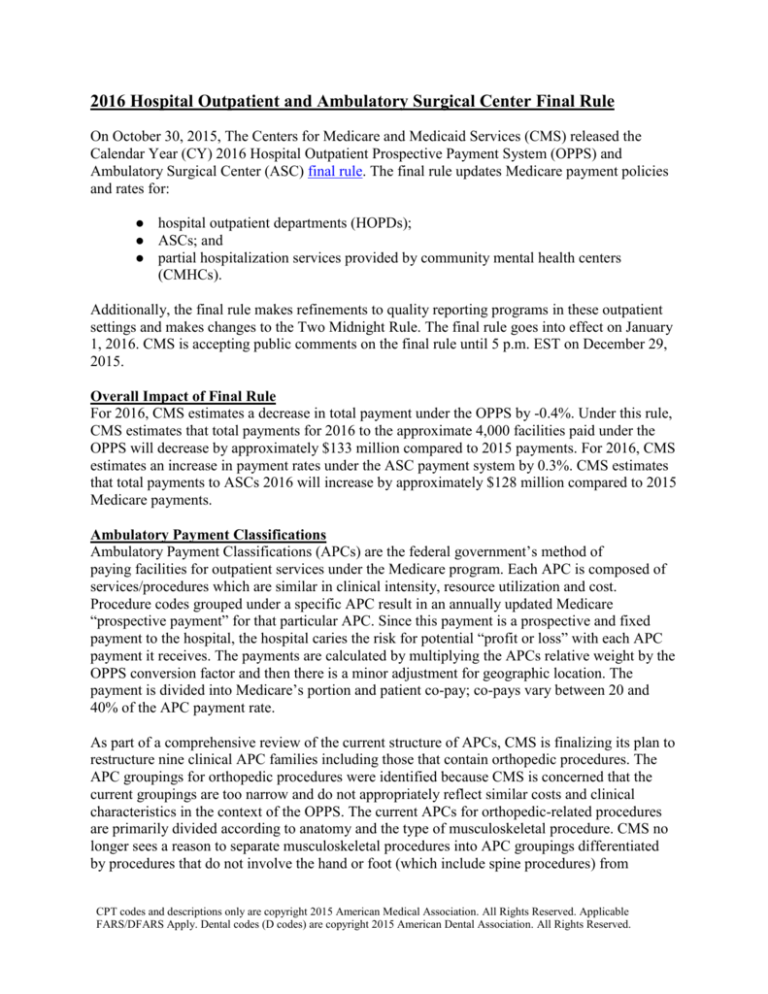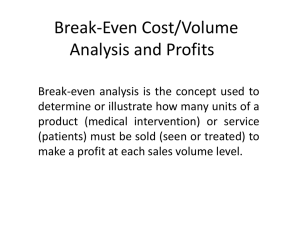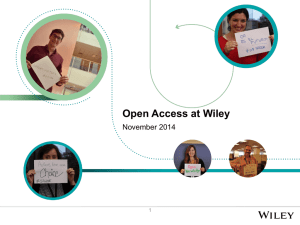
2016 Hospital Outpatient and Ambulatory Surgical Center Final Rule
On October 30, 2015, The Centers for Medicare and Medicaid Services (CMS) released the
Calendar Year (CY) 2016 Hospital Outpatient Prospective Payment System (OPPS) and
Ambulatory Surgical Center (ASC) final rule. The final rule updates Medicare payment policies
and rates for:
hospital outpatient departments (HOPDs);
ASCs; and
partial hospitalization services provided by community mental health centers
(CMHCs).
Additionally, the final rule makes refinements to quality reporting programs in these outpatient
settings and makes changes to the Two Midnight Rule. The final rule goes into effect on January
1, 2016. CMS is accepting public comments on the final rule until 5 p.m. EST on December 29,
2015.
Overall Impact of Final Rule
For 2016, CMS estimates a decrease in total payment under the OPPS by -0.4%. Under this rule,
CMS estimates that total payments for 2016 to the approximate 4,000 facilities paid under the
OPPS will decrease by approximately $133 million compared to 2015 payments. For 2016, CMS
estimates an increase in payment rates under the ASC payment system by 0.3%. CMS estimates
that total payments to ASCs 2016 will increase by approximately $128 million compared to 2015
Medicare payments.
Ambulatory Payment Classifications
Ambulatory Payment Classifications (APCs) are the federal government’s method of
paying facilities for outpatient services under the Medicare program. Each APC is composed of
services/procedures which are similar in clinical intensity, resource utilization and cost.
Procedure codes grouped under a specific APC result in an annually updated Medicare
“prospective payment” for that particular APC. Since this payment is a prospective and fixed
payment to the hospital, the hospital caries the risk for potential “profit or loss” with each APC
payment it receives. The payments are calculated by multiplying the APCs relative weight by the
OPPS conversion factor and then there is a minor adjustment for geographic location. The
payment is divided into Medicare’s portion and patient co-pay; co-pays vary between 20 and
40% of the APC payment rate.
As part of a comprehensive review of the current structure of APCs, CMS is finalizing its plan to
restructure nine clinical APC families including those that contain orthopedic procedures. The
APC groupings for orthopedic procedures were identified because CMS is concerned that the
current groupings are too narrow and do not appropriately reflect similar costs and clinical
characteristics in the context of the OPPS. The current APCs for orthopedic-related procedures
are primarily divided according to anatomy and the type of musculoskeletal procedure. CMS no
longer sees a reason to separate musculoskeletal procedures into APC groupings differentiated
by procedures that do not involve the hand or foot (which include spine procedures) from
CPT codes and descriptions only are copyright 2015 American Medical Association. All Rights Reserved. Applicable
FARS/DFARS Apply. Dental codes (D codes) are copyright 2015 American Dental Association. All Rights Reserved.
procedures that do include the hand or foot. For 2016, CMS is finalizing its plan to the
restructure the twenty-four APCs containing orthopedic surgery procedures into ten APCs.
It should be noted that CMS revised its initial proposal in response to commenters to the
proposed rule who were concerned that the proposed four levels of musculoskeletal APCs
resulted in extremely wide cost ranges. In response to these comments on the proposed rule,
CMS added a fifth level to the musculoskeletal APC grouping. Several procedures that were
proposed to be assigned to APC 5123 (Level 3 Musculoskeletal Procedures) are now reassigned
APC 5124 (Level 4 Musculoskeletal Procedures) for 2016. Similarly, several procedures that
were proposed to be assigned to APC 5124 (Level 4 Musculoskeletal Procedures) are now
reassigned to new APC 5125 (Level 5 Musculoskeletal Procedures) for 2016. CMS is revising
the APC assignment for the procedure described by CPT® 27279 from APC 5124 to APC 5125.
The geometric mean cost of APC 5125 is approximately $11,027, which is higher than the
proposed geometric mean cost of APC 5124 of approximately $9,789.
The table below lists the final 2016 APCs that result from the restructuring and consolidation of
the current orthopedic-related procedure APCs along with the final payment rates. See the
attached spreadsheet for more detailed information on APC payment rates and procedures
assigned to each APC.
CY 2016
APC
5101
5102
5111
5112
5113
5121
5122
5123
5124
5125
CY 2016 APC Group Title
Level 1 Strapping and Cast Application
Level 2 Strapping and Cast Application
Level 1 Closed Treatment Fracture and Related Services
Level 2 Closed Treatment Fracture and Related Services
Level 3 Closed Treatment Fracture and Related Services
Level 1 Musculoskeletal Procedures
Level 2 Musculoskeletal Procedures
Level 3 Musculoskeletal Procedures
Level 4 Musculoskeletal Procedures
Level 5 Musculoskeletal Procedures
Comprehensive Ambulatory Payment Classifications (C-APCS)
A C-APC is an APC that provides for an encounter-level payment for a designated primary
procedure and generally, all adjunctive and secondary services provided in conjunction with the
primary procedure. There are currently 25 C-APCs for 2015, which mostly include procedures
that include the implantation of costly medical devices. For 2016, CMS is finalizing its plan to
establish 10 additional C-APCs to be paid under the existing C-APC payment policy. There will
now be three musculoskeletal APCs designated as C-APCs (listed in the table below)--those
newly added in 2016 are denoted with an asterisk:
CPT codes and descriptions only are copyright 2015 American Medical Association. All Rights Reserved. Applicable
FARS/DFARS Apply. Dental codes (D codes) are copyright 2015 American Dental Association. All Rights Reserved.
CY 2016 C-APC+ CY 2016 APC Group Title
5123
5124
5125
Clinical Family New C-APC
Level 3 Musculoskeletal Procedures ORTHO
Level 4 Musculoskeletal Procedures ORTHO
Level 5 Musculoskeletal Procedures ORTHO
*
*
Change in OPPS Device Pass-Through Process
Device pass-through payments are intended to enable initial access to certain new medical
devices. CMS currently accepts and reviews applications for device pass-through on a quarterly
basis through a subregulatory process. CMS is finalizing its plan to evaluate device pass-through
applications through annual rulemaking in addition to the quarterly subregulatory review
process. In addition, CMS is implementing a newness criterion for device pass-through
applications under which applications must be submitted within three years of FDA
approval/clearance or the date of market availability if there is a documented, verifiable delay in
market availability after FDA approval or clearance.
Device-Intensive Procedures Under the OPPS
Under the OPPS, device-intensive APCs are defined as those APCs with a device offset greater
than 40%. In assigning device-intensive status to an APC, the device costs of all of the
procedures within the APC are calculated and the geometric mean device offset of all of the
procedures must exceed 40%. Almost all of the procedures assigned to device-intensive APCs
utilize devices, and the device costs for the associated HCPCS codes exceed the 40% threshold.
The no cost/full credit and partial credit device policy applies to device-intensive APCs; a related
device policy is the requirement that procedures assigned to certain (formerly device-dependent)
APCs require the reporting of a device code on the claim. APC 5125 (Level 5 Musculoskeletal
Procedures) is the only musculoskeletal APC classified as device-intensive.
CMS is finalizing its plan that only the procedures that require the implantation of a device that
are assigned to a device-intensive APC will require a device code on the claim. CMS is also
finalizing its plan that the claims processing edits are such that any device code, when reported
on a claim with a procedure assigned to a device-intensive APC will satisfy the edit.
Additionally, CMS is finalizing its plan to continue to reduce the OPPS payment for deviceintensive APCs by the full or partial credit a provider receives for a replaced device. CMS is also
finalizing the proposal to no longer specify a list of devices to which the OPPS payment
adjustment for no cost/full credit and partial credit devices would apply and instead, apply this
APC payment adjustment to all replaced devices furnished in conjunction with a procedure
assigned to a device-intensive APC when the hospital receives a credit for a replaced specified
device that is 50% or greater than the cost of the device.
Changes to the Inpatient Only List
For 2016, CMS is removing nine procedures from the Inpatient-Only List. In order to remove a
procedure from the Inpatient-Only List, CMS must determine the following:
CPT codes and descriptions only are copyright 2015 American Medical Association. All Rights Reserved. Applicable
FARS/DFARS Apply. Dental codes (D codes) are copyright 2015 American Dental Association. All Rights Reserved.
1. Most outpatient departments are equipped to provide the services to the Medicare
population;
2. The simplest procedure described by the code may be performed in most outpatient
departments;
3. The procedure is related to codes that CMS has already removed from the inpatient
only list;
4. A determination is made that the procedure is being performed in numerous hospitals
on an outpatient basis; and
5. A determination is made that the procedure can be appropriately and safely performed
in an ASC, and is on the list of approved ASC procedures or has been proposed by us
for addition to the ASC list.
Of the nine procedures CMS is removing from the Inpatient-Only List, four relate to spine:
Code
20936
20937
20938
22552
Long Descriptor
Autograft for spine surgery only (includes harvesting the
graft); local (e.g., ribs, spinous process, or laminar fragments)
obtained from same incision
Autograft for spine surgery only (includes harvesting the
graft); morselized (through separate skin or fascial incision)
Autograft for spine surgery only (includes harvesting the
graft); structural bicortical or tricortical (through separate skin
or fascial incision)
Arthrodesis, anterior interbody, including disc space
preparation, discectomy, osteophytectomy and decompression
of spinal cord and/or nerve roots; cervical below C2, each
additional interspace
Additions to the List of ASC Covered Surgical Procedures
CMS is adding seventeen procedures to the ASC list of covered surgical procedures. CMS
determined that these procedures would not be expected to pose a significant risk to beneficiary
safety when performed in an ASC, and would not be expected to require active medical
monitoring and care of the beneficiary at midnight following the procedure. Of the seventeen
procedures, four relate to spine:
Code Long Descriptor
Insertion of posterior spinous process distraction
device (including necessary removal of bone or
0171T
ligament for insertion and imaging guidance), lumbar;
single level
Insertion of posterior spinous process distraction
device (including necessary removal of bone or
0172T
ligament for insertion and imaging guidance), lumbar;
each additional level
ASC Payment Indicator
J8 - Device-intensive procedure;
paid at adjusted rate.
N1 - Packaged service/item; no
separate payment made.
CPT codes and descriptions only are copyright 2015 American Medical Association. All Rights Reserved. Applicable
FARS/DFARS Apply. Dental codes (D codes) are copyright 2015 American Dental Association. All Rights Reserved.
Laminectomy, facetectomy, and foraminotomy
(unilateral or bilateral with decompression of spinal
63046 cord, cauda equine and/or nerve root(s), eg spinal or
lateral recess stenosis, single vertebral segment;
thoracic
G2 - Non office-based surgical
procedure added in CY 2008 or
later; payment based on OPPS
relative payment weight.
G2 - Non office-based surgical
procedure added in CY 2008 or
Transpedicular approach with decompression of spinal
later; payment based on OPPS
63055 cord, equine and/or nerve root(s) (eg, herniated
relative payment weight.
intervertebral disc), single segment; thoracic
Device-Intensive Procedures in ASCs
CMS redefined ASC device-intensive procedures for 2015 as those procedures that are assigned
to any APC with a device offset percentage greater than 40% based on the standard OPPS APC
rate setting methodology. Payment rates for ASC device-intensive procedures are based on a
modified payment methodology.
CMS is finalizing its plan to apply the full credit/partial credit (FB/FC) device adjustment policy
to all device-intensive procedures in an ASC in 2016. The device-intensive procedures related to
spine for 2016 are listed in the table below. For 2016, CMS will reduce the payment for the
procedures listed in the table by the full device offset amount if a device is furnished without
cost or with full credit. ASCs must append the HCPCS modifier ‘‘FB’’ to the HCPCS code for a
surgical procedure listed in the table when the device is furnished without cost or with full credit.
In addition, for 2016, CMS will reduce the payment for the procedures listed in the table below
by one-half of the device offset amount if a device is provided with partial credit, if the credit to
the ASC is 50% or more (but less than 100%) of the device cost. The ASC must append the
HCPCS “FC” modifier to the HCPCS code for a surgical procedure listed in the table below
when the facility receives a partial credit of 50% or more (but less than 100%) of the cost of a
device.
Final CY 2016
Code Short Descriptor
ASC Payment
Indicator
J8 - Deviceintensive
Lumbar spine proces procedure; paid
0171T
at adjusted rate.
distract
Neck spine fuse &
22551
remov bel c2
Final CY Final CY 2016
2016 OPPS Device Offset
APC
Percentage
Final FB/FC
Policy Will
Apply
5125
Y
J8 - Deviceintensive
5125
procedure; paid
at adjusted rate.
53.97%
53.97%
Y
CPT codes and descriptions only are copyright 2015 American Medical Association. All Rights Reserved. Applicable
FARS/DFARS Apply. Dental codes (D codes) are copyright 2015 American Dental Association. All Rights Reserved.
J8 - Deviceintensive
22554
5125
procedure; paid
at adjusted rate.
Arthrodesis sacroiliac J8 - Devicejoint
intensive
27279
5125
procedure; paid
at adjusted rate.
Neck spine fusion
53.97%
Y
53.97%
Y
Two Midnight Rule
For 2016, CMS is finalizing its proposal to update the Two-Midnight rule. CMS adopted the
Two-Midnight rule for admissions beginning on or after October 1, 2013. This rule established
Medicare payment policy regarding the benchmark criteria to use when determining whether
inpatient admission is reasonable and necessary for purposes of payment under Medicare Part A.
In general, the original Two-Midnight rule states that:
• Inpatient admissions would generally be payable under Part A if the admitting
practitioner expected the patient to require a hospital stay that crossed two midnights and
the medical record supported that reasonable expectation.
• Medicare Part A payment was generally not appropriate for hospital stays expected to last
less than two midnights. Cases involving a procedure identified on the inpatient-only list
or that were identified as “rare and unusual exception” to the Two-Midnight benchmark
by CMS were exceptions to this general rule and were deemed to be appropriate for
Medicare Part A payment.
Beginning in 2016, for stays expected to last less than two midnights – CMS is adopting the
following policies:
• For stays for which the physician expects the patient to need less than two midnights of
hospital care (and the procedure is not on the inpatient-only list or otherwise listed as a
national exception), an inpatient admission may be payable under Medicare Part A on a
case-by-case basis based on the judgment of the admitting physician. The documentation
in the medical record must support that an inpatient admission is necessary, and is subject
to medical review.
• CMS is reiterating the expectation that it would be unlikely for a beneficiary to require
inpatient hospital admission for a minor surgical procedure or other treatment in the
hospital that is expected to keep him or her in the hospital for a period of time that is only
for a few hours and does not span at least overnight. CMS will monitor the number of
these types of admissions and plans to prioritize these types of cases for medical review.
CMS is making no changes for stays over the two-midnight benchmark:
• For hospital stays that are expected to be two midnights or longer, CMS’ policy is
unchanged; that is, if the admitting physician expects the patient to require hospital care
that spans at least two midnights, the services are generally appropriate for Medicare Part
A payment. This policy applies to inpatient hospital admissions where the patient is
reasonably expected to stay at least two midnights, and where the medical record
supports that expectation that the patient would stay at least two midnights. This includes
stays in which the physician’s expectation is supported, but the length of the actual stay
CPT codes and descriptions only are copyright 2015 American Medical Association. All Rights Reserved. Applicable
FARS/DFARS Apply. Dental codes (D codes) are copyright 2015 American Dental Association. All Rights Reserved.
was less than two midnights due to unforeseen circumstances such as unexpected patient
death, transfer, clinical improvement or departure against medical advice.
The final rule also includes changes to CMS’ approach to educating hospitals and enforcement of
the Two Midnight rule. Specifically, CMS began using Beneficiary and Family Centered Care
(BFCC) QIOs, rather than Medicare Administrative Contractors or Recovery Auditors, to
conduct the initial medical reviews of providers who submit claims for short stay inpatient
admissions on October 1, 2015. Beginning in 2016, BFCC-QIOs will begin reviewing inpatient
cases under the revised Two Midnight Rule. BFCC-QIO reviews of short inpatient hospital
claims focus on educating doctors and hospitals about the Part A payment policy for inpatient
admissions. BFCC-QIOs will refer providers to the Recovery Auditors based on patterns of
practices, such as high rates of claims denial after medical review or failure to improve after QIO
assistance has been rendered.
Next Steps:
CMS is accepting public comments on the final rule until 5 p.m. EST on December 29, 2015.
The final rule goes into effect on January 1, 2016.
Important Links:
Full Text of Final Rule: https://www.federalregister.gov/articles/2015/11/13/201527943/medicare-program-hospital-outpatient-prospective-payment-and-ambulatory-surgicalcenter-payment
CMS Fact Sheet on Final Rule:
https://www.cms.gov/Newsroom/MediaReleaseDatabase/Fact-sheets/2015-Fact-sheetsitems/2015-10-30-3.html
CMS Fact Sheet on Two Midnight Rule Section of Final Rule:
https://www.cms.gov/Newsroom/MediaReleaseDatabase/Fact-sheets/2015-Fact-sheetsitems/2015-10-30-4.html
Final Rule - OPPS Addenda and Attachments: https://www.cms.gov/Medicare/Medicare-Feefor-Service-Payment/HospitalOutpatientPPS/Hospital-Outpatient-Regulations-and-NoticesItems/CMS-1633-FC.html
Final Rule - ASC Addenda and Attachments: https://www.cms.gov/Medicare/Medicare-Fee-forService-Payment/ASCPayment/ASC-Regulations-and-Notices-Items/CMS-1633FC.html?DLPage=1&DLEntries=10&DLSort=2&DLSortDir=descending
Submit Individual Comments to the Final Rule at:
http://www.regulations.gov/#!documentDetail;D=CMS-2015-0075-0632
Note: Click on the blue “Comment Now!” button in the upper right hand corner.
CPT codes and descriptions only are copyright 2015 American Medical Association. All Rights Reserved. Applicable
FARS/DFARS Apply. Dental codes (D codes) are copyright 2015 American Dental Association. All Rights Reserved.





